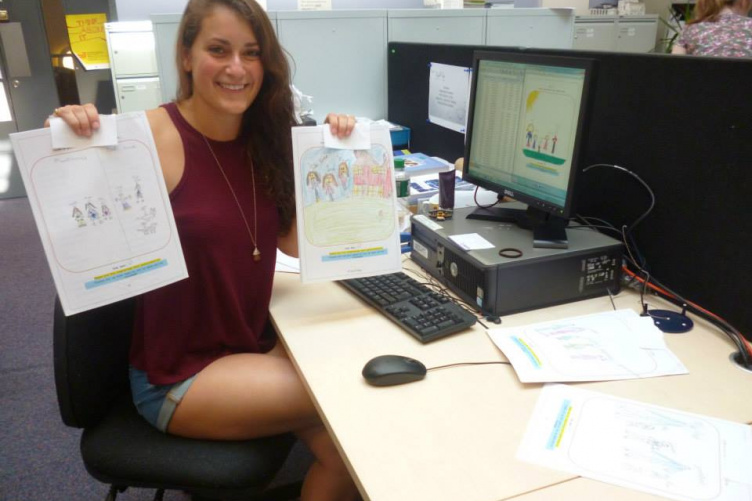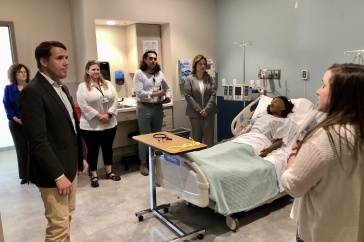
Julianne Shimer holds up some of the family-life drawings she helped analyze while in Dublin for her 2014 Summer Undergraduate Research Fellowship.
Julianne Shimer ’15 spent her summer in Dublin, Ireland, analyzing the drawings of disadvantaged youth. She was there as a summer staff member in the Trinity College Nursing and Midwifery Department, where, as part of the Healthy Schools Programme, she contributed to a project that will help disadvantaged children by establishing quantifiable correlations between the pictures they draw and their mental health.
A nursing major in the College of Health and Human Services, Shimer received a grant from the Hamel Center for Undergraduate Research to fund her nine-week study, “The Healthy Schools Programme: What Can Be Learned About the Health and Well-Being Needs of Disadvantaged Children Through Visual Content Analysis?” She worked closely with Trinity’s Dr. Catherine Comiskey and PhD candidate Sonam Banka.
We asked her about her experience.
UNH Today: What is the Healthy Schools Programme and how did you find out about it?
Shimer: The Healthy Schools Programme is an intervention program based on the health-promoting model of the World Health Organization, which began in 2009 at Trinity College Dublin in Ireland. The project was funded by the Childhood Development Initiative to improve the health and well‑being of urban disadvantaged children in Irish populations.
I was very lucky that one of my nursing professors was from Ireland. I was interested in research and wanted to do it abroad if possible, so I got in contact with her. It all started off very casually, finding out if she had any connections she could share, and before I knew it I was e-mailing different people in Ireland and was quickly connected with the Healthy Schools Programme. Looking back, it all seems surreal.
UNH Today: What, exactly, is visual content analysis?
Shimer: Visual content analysis is similar to content analysis, in which interviews or articles are reviewed and coded for common themes, only with this, it’s visual data—things like colors and common symbols like smiling faces and sad faces—that is coded. It is a way to quantify visual data to test a hypothesis. Codes are developed by finding themes that are repeatedly represented in a sample. Each drawing is looked at individually and coded, and once this data is collected, the codes and variables can be compared with other aspects of a research area. In this particular study, we compared the different codes to depression scores from the Children’s Depression Inventory. We’re hopeful that finding patterns between particular codes and depression scores can help explain our subjects’ mental states and how they perceive the world.
UNH Today: Tell us about the work you did.
Shimer: The research was psychology- and nursing-based. The drawings were collected from the children before I arrived, so most of my work took place in the Trinity Nursing and Midwifery Department. It was mostly data entry and analysis. Although I was not present for data collection, I was briefed on the process and don’t feel that I missed out on learning that vital part of research.
UNH Today: Describe your average day.
Shimer: Each week at the Trinity Nursing and Midwifery Department was different. At the beginning I needed to do a great deal of reading on visual content analysis, attend meetings with the team to decide the best methods, and start literature reviews. It felt great to be part of a team and learn all the ins and outs of research—how plans change, how to time manage. Later on into my nine weeks, I worked more with the drawings—going through them, looking for common themes, working with the team to develop the final list of codes, and then finally coding all of the drawings. After all the drawings were coded we got to compare the results with the depression scores previously collected to see whether our hypothesis—that children’s interpretations of family life through drawings are dependent on their depressive symptoms—was supported.
UNH Today: What did you learn?
Shimer: I learned that, on a project like this, no one person can do it all—it truly is a team effort. I also learned to be more flexible, because priorities, ideas, and plans change all the time in research. I saw this when we changed our original focus from being qualitative to quantitative. I also learned how visual content analysis can be an easy tool to use and can have some telling results. Our team found that certain aspects in children's drawings were statistically significant and corresponded with depressive symptoms, for example, illustrating separate families and sad faces; where children who were in the non-depressed category showed significant results in that more mothers, siblings, and family portraits were drawn.
UNH Today: Where did you live?
Shimer: My living situation was one of the best parts about my experience abroad. I lived with a family a little bit outside of the city in a more residential area. I finally had a little sister and my host mom was a great cook, so welcoming, and she made me feel like part of the family. Can’t forget the dog and the chickens as well! The family I stayed with also took in other students, all of whom were there to learn English, so I had roommates from Venezuela, Switzerland and Brazil. I was their first student from the United States. Our family dinners mostly consisted of sharing the differences and similarities between our countries; I found it all so interesting. Leaving them all was very emotional. I feel like I have a second family now.
In her downtime...

Left to right: Julianne Shimer crossing the Carrick-a-Rede rope bridge while on the way to Belfast for a weekend day trip; the Cliffs of Moher; Giants Causeway; a cliff on the edge of the town of Dingle in the West of Ireland.
Photos courtesy of Julianne Shimer
Related:
-
Written By:
Tracey Bentley | Communications and Public Affairs


















































